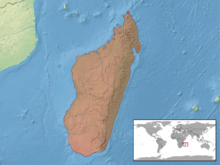Malagasy Giant Chameleon
| Malagasy giant chameleon | |
|---|---|
 |
|
| Female Furcifer oustaleti in the Anjajavy Forest | |
| Scientific classification | |
| Kingdom: | Animalia |
| Phylum: | Chordata |
| Subphylum: | Vertebrata |
| Class: | Reptilia |
| Order: | Squamata |
| Suborder: | Sauria |
| Infraorder: | Iguania |
| Family: | Chamaeleonidae |
| Genus: | Furcifer |
| Species: | F. oustaleti |
| Binomial name | |
|
Furcifer oustaleti (Mocquard, 1894) |
|
 |
|
The Malagasy giant chameleon or Oustalets's chameleon (Furcifer oustaleti ) is a very large species of chameleon which is endemic to Madagascar, but also has been introduced near Nairobi in Kenya (though its current status there is unclear).
F. oustaleti occurs in a wide range of habitats, even among degraded vegetation within villages, but is relatively rare in primary forest.
With a maximum total length (including tail) of 68.5 cm (27 in), F. oustaleti is considered the largest species of chameleon, but that claim is occasionally contested by the Parsons chameleon Calumma parsonii as the Parsons tends to be more heavily built but slightly shorter in length.
The diet of F. oustaleti includes, but is not limited to, invertebrates such as large insects. Prey is acquired with a long, muscular tongue.
The generic name, Furcifer, is derived from the Latin root furci meaning "forked" and refers to the shape of the animal's feet.
The specific name, oustaleti, is a Latinized form of the last name of French biologist Jean-Frédéric Émile Oustalet, in whose honor the species is named.
...
Wikipedia

